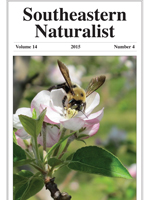Forested wetlands represent some of the most distinct environments in the Lower Mississippi Alluvial Valley. Depending on season, water in forested wetlands can be warm, stagnant, and oxygen-depleted, yet may support high fish diversity. Fish assemblages in forested wetlands are not well studied because of difficulties in sampling heavily structured environments. During the April–July period, we surveyed and compared the water quality and assemblages of small fish in a margin wetland (forested fringe along a lake shore), contiguous wetland (forested wetland adjacent to a lake), and the open water of an oxbow lake. Dissolved-oxygen levels measured hourly 0.5 m below the surface were higher in the open water than in either of the forested wetlands. Despite reduced water quality, fish-species richness and catch rates estimated with light traps were greater in the forested wetlands than in the open water. The forested wetlands supported large numbers of fish and unique fish assemblages that included some rare species, likely because of their structural complexity. Programs developed to refine agricultural practices, preserve riparian zones, and restore lakes should include guidance to protect and reestablish forested wetlands.
How to translate text using browser tools
1 December 2015
Fish and Water Quality in the Forested Wetlands Adjacent to an Oxbow Lake
Caroline S. Andrews,
Leandro E. Miranda,
Robert Kroger
ACCESS THE FULL ARTICLE

Southeastern Naturalist
Vol. 14 • No. 4
December 2015
Vol. 14 • No. 4
December 2015




